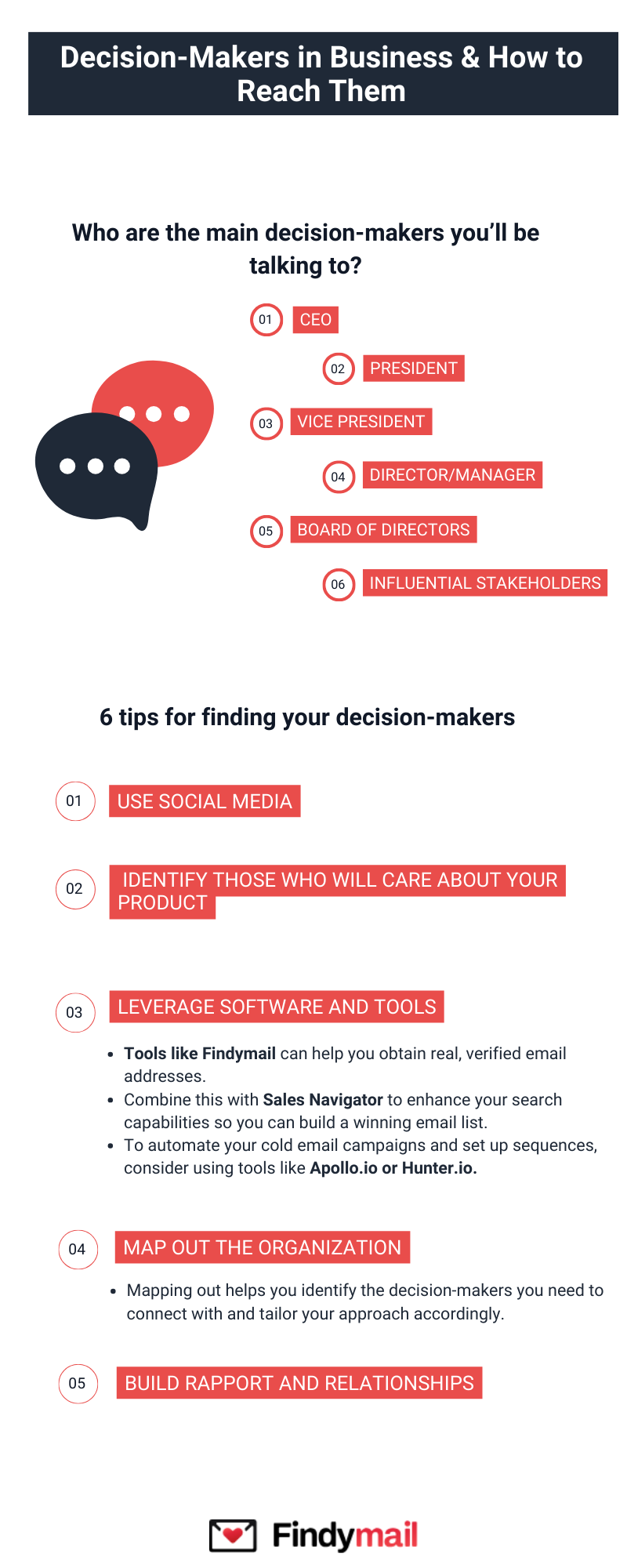Have you ever felt like you're spinning your wheels in B2B sales? Reaching the right business decision makers can make or break your sales success. You can have a rockstar sales team, but if they can't connect with the right people, all their efforts can go down the drain.
In today's competitive business environment, identifying and engaging key decision makers is crucial for B2B sales success. This comprehensive guide will show you how to find, approach, and connect with business leaders who have the authority to approve your proposals and drive purchasing decisions.
Trust me; I've been there. That's why I'm here to share everything you need to know about those all-important decision-makers and how to approach and close them successfully. We'll explore proven strategies for connecting with C-suite executives, department heads, and influential stakeholders across different organizational structures.
What you'll learn in this guide:
- How to identify key decision makers and their roles
- Effective strategies for reaching business leaders
- Tools and techniques for finding contact information
- Best practices for engaging with different types of decision makers
- Common mistakes to avoid when approaching stakeholders
What Are Business Decision Makers? Understanding Key Stakeholders
Business decision makers are individuals within an organization who have the authority, budget, and influence to make purchasing decisions or approve business initiatives. These key stakeholders include C-level executives, department heads, managers, and influential team members who can impact your sales process.
Understanding the decision-making process in businesses is essential for successful B2B sales. Decision makers evaluate proposals based on ROI, budget constraints, strategic alignment, and organizational needs. They often work with buying committees and influence networks to make informed choices.
Decision Makers vs. Gatekeepers
Alright, let's first clear up the difference between decision-makers and gatekeepers and figure out who's who. Understanding this distinction is crucial for navigating corporate hierarchies and reaching the right stakeholders.
So, decision-makers. These are the big shots with the power to make dreams come true (or crush them). They're the ones who give the final nod to your proposals. These business leaders have budget authority, strategic oversight, and the influence to drive organizational change.
They're high-level executives or managers who call the shots, dish out the budgets, and set the company's course. Basically, they're holding the keys to the kingdom, and your goal is to win them over.
Then gatekeepers – well, picture them as the gatekeepers (duh!) to the decision-makers. They're like the bouncers at the coolest club in town. These individuals control access to decision makers and can significantly influence whether your message reaches the right person.
Gatekeepers can be executive assistants, department heads, or influential folks who control access. They don't have the final say, but you might need to impress them to even get a chance.
Throughout your quest toward the decision-maker, you'll need to make gatekeepers your allies. Building positive relationships with these stakeholders can accelerate your sales process and provide valuable insights into organizational dynamics.
Types of Business Decision Makers: Key Stakeholders and Their Roles
When it comes to decision-makers in business, there's a cast of characters that you should get familiar with. Understanding the organizational structure and hierarchy helps you identify the right stakeholders for your specific product or service. Let's meet the key players who hold the power to sign off on your proposals and make things happen:
C-Suite Executives and Senior Leadership
- CEO (Chief Executive Officer): The big cheese, the top dog. The CEO is the head honcho of the company, responsible for the overall strategic direction and decision-making. Their approval can make or break your proposal. As the ultimate business decision maker, CEOs focus on strategic initiatives, company growth, and long-term vision. They typically evaluate proposals based on overall business impact and ROI.
- President: Depending on the organization, the President may have different roles and responsibilities. They could be the second-in-command after the CEO, overseeing operations or specific departments. Their buy-in is vital for major decisions. Presidents often serve as key decision makers for operational changes and departmental initiatives.
- Vice President: VPs come in a variety of flavors, such as VP of Sales, Marketing, Finance, or Operations. They play a crucial role in their respective areas and often have decision-making authority within their domains. Building rapport with VPs can open doors to getting your proposal in front of the right people. These senior stakeholders are essential decision makers for departmental budgets and strategic initiatives.
Department Heads and Middle Management
- Director/Manager: These are the folks who oversee specific departments or teams within the organization. They may have decision-making authority for projects or initiatives within their scope. Collaborating with them can pave the way to reaching higher-level decision-makers. These operational decision makers understand day-to-day challenges and can provide insights into organizational needs.
Board Members and Influential Stakeholders
- Board of Directors: The esteemed group of individuals responsible for governance and overseeing the organization's strategic direction. They are usually high-profile individuals with vast experience and influence. Gaining their support can be a game-changer for your proposal. Board members serve as ultimate decision makers for major investments and strategic direction changes.
- Influential Stakeholders: Depending on the nature of your proposal, other stakeholders within the company may hold decision-making authority. It could be department heads, project managers, or key team leaders who have a say in the initiatives they oversee. These stakeholders often participate in the decision-making process and can influence final outcomes through their expertise and organizational relationships.

Remember, decision-makers come in all shapes and sizes within an organization. Understanding who they are and their respective roles is crucial in tailoring your approach and building relationships with them. Each type of business decision maker has different priorities, communication preferences, and decision-making criteria that you must consider in your outreach strategy.
How to Approach Different Types of Business Decision Makers
Approaching the CEO
When engaging with CEO-level decision makers, your approach must be strategic, concise, and value-focused. CEOs are time-constrained executives who evaluate proposals based on strategic impact and business outcomes.
If you want to win over the big dog, understanding their background is critical. Research their preferences and tailor your pitch accordingly. Study their leadership style, company priorities, recent initiatives, and industry challenges to craft a compelling message.
When pitching a CEO, you need to exude confidence and avoid using complex jargon. Keep your pitch concise and be prepared to address any questions they may have. Focus on high-level business outcomes, ROI metrics, and strategic advantages rather than technical details.
Remember, their time is precious, so respect their schedule and get to the point quickly. Anticipate their sharp mind and be ready with well-thought-out responses.
Lastly, connect on a personal level to establish rapport. Show authenticity and let your passion shine through. CEOs appreciate genuine business leaders who understand market dynamics and can articulate clear value propositions.
Approaching the President
Presidents serve as key decision makers who bridge strategic vision with operational execution. Your approach should demonstrate how your solution aligns with both company objectives and operational efficiency.
Approaching the president requires finesse, conviction, and a deep understanding of their goals. Research their specific responsibilities, departmental oversight, and key performance indicators to tailor your message effectively.
Show them that you believe in the value of your product or service and how it aligns with their goals. Confidence is contagious and can inspire trust in your proposition.
Highlight the ways your offering can directly contribute to their objectives. Help them envision the positive impact it will have on their business. Present case studies, ROI calculations, and success metrics that resonate with their operational focus.
Clearly articulate how your product/service can help them overcome challenges, seize opportunities, or achieve greater efficiency. Focus on practical benefits and measurable outcomes that align with their decision-making criteria.
Approaching the Vice President, Manager, or Stakeholder
Mid-level decision makers often have deep operational knowledge and specific departmental objectives. Your approach should demonstrate understanding of their day-to-day challenges and departmental goals.
When pitching the vice president, manager, or stakeholder, you can follow a similar approach to pitching the president, but with a strategic twist – incorporate their specific goals into your pitch to demonstrate how your product/service will help them get there. Research their department's key performance indicators, budget constraints, and upcoming initiatives.
Be prepared to answer any questions they may have and keep your pitch focused and to the point. These decision makers often evaluate solutions based on practical implementation, team impact, and departmental ROI.
Of course, you'll need to get to this point, so let's look at some tips and tricks for finding decision-makers and what to do when you've figured it out. The key is building relationships with these stakeholders who can champion your solution within their organization.
6 Proven Strategies for Finding Business Decision Makers
Here are 6 tips I've used over the years that have helped me hone in on key players and get them down my sales pipeline. These strategies will help you identify and connect with the right decision makers in your target organizations.
1) Leverage Social Media for Decision Maker Research
Social media platforms like LinkedIn and Twitter can be gold mines for finding decision-makers and establishing contact with them. These platforms provide valuable insights into organizational structures, professional backgrounds, and business priorities of key stakeholders.
You can send direct messages but don't limit yourself to just that. Use social media to research company news, industry trends, and individual professional interests that can inform your outreach strategy.
Take advantage of these platforms to gather information and find email addresses. Cold emails are a powerful tactic; they can effectively grab the decision-maker's attention. Social selling approaches can help you build relationships with business decision makers before making direct sales pitches.
2) Identify Stakeholders Who Will Benefit Most from Your Solution
While talking to the CEO might seem like the ultimate goal, sometimes you need to zoom in on the person within the company who will benefit the most from your product or solution. Focus on finding the decision makers whose pain points align directly with your value proposition.
Do your research and find the individual who will experience the greatest impact. Look for department heads, project managers, or operational leaders who face the specific challenges your solution addresses.
Engage them in a meaningful conversation by bringing up something relevant you discovered about their company, whether it's from the news, their corporate website, or even their Twitter account. Reference industry trends, company initiatives, or market challenges that demonstrate your understanding of their business environment.
Focus on discussing the problem you are solving rather than immediately diving into your product. This consultative approach positions you as a trusted advisor rather than just another salesperson.
For example, if you're selling email security software, you could say something like, "Hey, curious to get your thoughts on the state of email security? What problems are you seeing out there with your clients?" This approach opens dialogue about business challenges and positions you as an industry expert.
3) Use Advanced Tools and Software for Decision Maker Identification
Make use of software and tools that can streamline your outreach efforts. Modern sales technology provides powerful capabilities for finding and verifying contact information for business decision makers.
Tools like Findymail can help you obtain real, verified email addresses. Combine this with Sales Navigator to enhance your search capabilities so you can build a winning email list. These platforms use advanced algorithms and data sources to provide accurate contact information and organizational insights.
To automate your cold email campaigns and set up sequences, consider using tools like Apollo.io or Hunter.io. Email automation tools help you scale your outreach while maintaining personalization for different types of decision makers.
Additionally, explore data enrichment tools that can fill in missing information about decision makers, such as their roles and contact details. These tools provide comprehensive profiles including job history, company information, and contact preferences.
4) Map Organizational Structure and Decision-Making Hierarchy
When targeting a company, it's important to understand its organizational structure. Tools like Sales Navigator or LinkedIn advanced search can provide valuable insights into who holds key positions within the company. Understanding reporting relationships, departmental structures, and decision-making processes helps you identify the most influential stakeholders.
By mapping out the organization, you can identify the decision-makers you need to connect with and tailor your approach accordingly. This research helps you understand who has budget authority, who influences purchasing decisions, and who will be involved in the evaluation process.
Create a stakeholder map that includes:
- Primary decision makers with budget authority
- Secondary influencers and advisors
- Technical evaluators and end users
- Procurement and legal contacts
- Executive sponsors and champions
5) Build Long-Term Relationships with Key Stakeholders
Establishing a rapport with decision-makers is essential. It's your job to find creative and relevant ways to stay on their radar. Relationship building with business decision makers requires consistent value delivery and genuine interest in their success.
Follow their content on social media, share insightful articles or industry news, and find opportunities to add value to their professional lives. Provide market insights, industry reports, and useful resources that help them make better business decisions.
Remember, building relationships takes time and effort. Be persistent but not pushy, and demonstrate that you genuinely care about their success. Long-term relationship building often leads to better sales outcomes than aggressive short-term tactics.
Effective relationship-building strategies include:
- Sharing relevant industry insights and market research
- Making introductions to valuable business contacts
- Providing educational content and thought leadership
- Attending industry events and conferences where they participate
- Engaging meaningfully with their social media content
6) Focus on Their Business Challenges, Not Your Product
Decision makers receive a constant stream of cold emails and sales pitches. They've seen it all – the flashy tricks and persuasive tactics. To stand out from the crowd, you need to be real, genuine, and, most importantly, focused on them. Successful engagement with business decision makers requires a consultative approach that prioritizes their needs over your sales objectives.
Shift your approach from a self-centered pitch to a customer-centric mindset. Take the time to understand their pain points, challenges, and goals. Research their industry trends, competitive pressures, and organizational objectives to demonstrate genuine understanding.
Show genuine interest in their success and the problems they face. This means doing your research, digging deep into their industry, and demonstrating that you have valuable insights to offer. Position yourself as a trusted advisor who understands their business environment and can provide strategic guidance.
Customer-centric approaches include:
- Leading with industry insights rather than product features
- Asking thoughtful questions about their business challenges
- Sharing relevant case studies from similar organizations
- Discussing market trends and competitive dynamics
- Offering strategic advice before introducing your solution
Best Practices for Engaging Business Decision Makers
Successfully engaging with business decision makers requires a strategic approach that combines research, personalization, and value delivery. Here are the key practices that drive results:
Research Thoroughly: Before reaching out, conduct comprehensive research on the company, industry, and individual decision maker. Understand their business model, recent news, competitive challenges, and strategic priorities.
Personalize Your Approach: Tailor your message to each decision maker's specific role, responsibilities, and interests. Reference their recent achievements, company initiatives, or industry involvement to demonstrate genuine interest.
Lead with Value: Always lead your conversations with insights, solutions, or opportunities that benefit them. Avoid generic pitches and focus on how you can help them achieve their goals.
Be Concise and Clear: Decision makers have limited time. Present your ideas clearly and concisely, focusing on the most important points that align with their priorities.
Follow Up Strategically: Develop a systematic follow-up process that adds value in each interaction. Share relevant articles, market insights, or introduce them to valuable contacts.
Build Multi-threaded Relationships: Engage with multiple stakeholders within the organization to understand different perspectives and build broader support for your solution.
Common Mistakes to Avoid When Reaching Business Decision Makers
Avoiding these common pitfalls will improve your success rate when engaging with business decision makers:
Mistake #1 - Generic Outreach: Sending the same message to all decision makers without personalization shows lack of research and genuine interest.
Mistake #2 - Feature-Heavy Presentations: Focusing on product features instead of business outcomes and value proposition fails to resonate with executive-level stakeholders.
Mistake #3 - Ignoring Organizational Hierarchy: Approaching decision makers without understanding reporting relationships and approval processes can create friction.
Mistake #4 - Aggressive Follow-up: Being too pushy or frequent with follow-ups can damage relationships and hurt your credibility.
Mistake #5 - Lack of Industry Knowledge: Failing to understand their industry challenges and competitive landscape undermines your credibility as a trusted advisor.
Mistake #6 - Poor Timing: Reaching out during busy periods or without considering their business calendar can reduce response rates.
Measuring Success: KPIs for Decision Maker Engagement
Track these key performance indicators to measure your success in reaching and engaging business decision makers:
Response Rates: Monitor email open rates, reply rates, and meeting acceptance rates across different types of decision makers.
Engagement Quality: Track meaningful conversations, referrals, and relationship progression indicators.
Pipeline Development: Measure how many qualified opportunities result from decision maker outreach efforts.
Relationship Building: Monitor social media engagement, content sharing, and ongoing communication with key stakeholders.
Conversion Metrics: Track how many decision maker relationships convert to sales opportunities and closed deals.
Time to First Meeting: Measure how quickly you can secure initial meetings with target decision makers.
Advanced Strategies for Enterprise Decision Makers
When targeting large enterprise organizations, your approach to business decision makers must be more sophisticated and strategic:
Account-Based Marketing: Develop comprehensive account plans that identify all key decision makers and influencers within target organizations.
Executive Briefing Centers: Leverage formal presentation opportunities to showcase your solution to multiple decision makers simultaneously.
Industry Events and Conferences: Engage with decision makers at industry events where they're more receptive to new ideas and networking.
Thought Leadership: Establish yourself as an industry expert through content marketing, speaking engagements, and strategic partnerships.
Reference Customers: Leverage existing customers to provide introductions and testimonials that resonate with similar decision makers.Executive Sponsorship: Engage senior leaders within your organization to connect with C-level decision makers at target accounts.
Make Your Own Opportunities with Findymail
When you find (and approach) decision-makers, you're paving the way to creating your own opportunities and success. Effective decision maker engagement requires the right combination of strategy, tools, and persistence to achieve consistent results.
Throughout this article, I've explored the ins and outs of connecting with these key individuals and provided valuable tips to help you navigate this challenging but rewarding task. The strategies outlined in this guide will help you build a systematic approach to identifying, reaching, and engaging with business decision makers across different industries and organization types.
And if you need a little help along the way, remember that Findymail has always got your back. Get legit email addresses for key decision-makers and more when building out your email list! Our platform provides verified contact information and advanced search capabilities that help you connect with the right stakeholders efficiently.
And if you want more fire info on how to take your next sales game to the next level, you know where to come 😉. Continue developing your sales skills and decision maker engagement strategies to achieve consistent success in B2B sales.
Until next time! Start implementing these proven strategies today and watch your success rate with business decision makers improve dramatically.
FAQ: Business Decision Makers and Stakeholder Engagement
How do you identify key decision makers in a business organization?
To identify business decision makers, use LinkedIn Sales Navigator to research company hierarchies, analyze organizational charts on company websites, leverage tools like Findymail for contact verification, and map reporting relationships. Look for C-suite executives, department heads, budget holders, and influential stakeholders who align with your solution. Research recent company announcements and press releases to understand current priorities and key personnel changes.
What are the most effective tools for finding decision makers?
The most effective tools include Findymail for verified email addresses, LinkedIn Sales Navigator for organizational research, ZoomInfo for comprehensive contact data, Apollo.io for prospecting automation, and Hunter.io for email finding. Combine multiple tools for best results and always verify contact information before outreach. Data enrichment platforms can provide additional insights about decision maker preferences and communication styles.
How long does it typically take to connect with business decision makers?
Connecting with business decision makers typically takes 2-6 weeks depending on the organization size, industry, and decision maker seniority. C-suite executives may require 4-8 touchpoints over several weeks, while department heads might respond within 2-3 weeks. Persistence, value-driven communication, and proper timing are key factors. Building relationships through social media and referrals can accelerate the process significantly.
What's the difference between decision makers and influencers in B2B sales?
Decision makers have final authority to approve purchases and sign contracts, while influencers provide input and recommendations that affect the decision-making process. Decision makers typically have budget authority and strategic oversight, whereas influencers may be technical evaluators, end users, or department stakeholders. Both are important for B2B sales success, and you should engage with multiple stakeholders throughout the sales process to build consensus.
How do you engage with decision makers who don't respond to initial outreach?
For non-responsive decision makers, try different communication channels (LinkedIn, phone, email), provide additional value in each follow-up, reference mutual connections or customers, share relevant industry insights or news, and consider reaching out through gatekeepers or assistants. Space your follow-ups appropriately and always add new value. Sometimes timing is the issue, so maintain consistent but respectful contact over time.






